In the world of filmmaking, achieving the perfect shot often hinges on the equipment used, and one crucial tool in a cinematographer's arsenal is the Professional Camera Matte Box. This essential accessory not only serves to manage light and control flare but also enhances the overall visual aesthetics of a film. Understanding how to effectively utilize a matte box can significantly elevate the quality of your shots, allowing for greater creativity and precision in storytelling. In this article, we will explore the various features and benefits of Professional Camera Matte Boxes, offering tips and techniques to help both budding filmmakers and seasoned professionals unlock their full potential. Whether you're aiming to minimize unwanted reflections or create stunning visual effects, mastering the use of a matte box can be a game changer in the pursuit of cinematic excellence.

In the realm of filmmaking, understanding the basics of camera matte boxes is essential for achieving professional-quality results. A matte box serves multiple purposes, such as preventing lens flares, managing lighting, and allowing the use of filters. The latest innovations in matte box design, like the lightweight models now available, highlight the shift towards modular and efficient setups. For instance, recent reviews of multifunctional modular matte boxes indicate that filmmakers can enjoy versatile and affordable options that do not compromise on quality.
The importance of rigging in maximizing a camera's potential cannot be overlooked. With the ever-increasing capabilities of mirrorless cameras, proper rigging becomes pivotal. Industry reports suggest that a solid rig can enhance stability and control, which is crucial during dynamic shooting conditions. As filmmakers adopt more complex rigs—including components such as monitoring devices, controllers, and matte boxes—mastering the integration of these elements contributes significantly to the overall cinematic experience. A well-built rig not only enhances the technical aspects of filmmaking but also empowers creators to focus on storytelling without the distraction of technical limitations.
Choosing the right matte box for your camera setup is crucial for achieving optimal results in filmmaking. With the booming growth of the film industry, which was valued at over $136 billion in 2021 and is projected to grow at a CAGR of 4.5% through 2026, filmmakers are increasingly investing in high-quality equipment, including matte boxes. A well-chosen matte box can help control lens flare, block unwanted light, and facilitate the use of filters, which are essential for capturing that perfect shot.
When selecting a matte box, it is important to consider factors such as the lens size and type of filters you wish to use. According to data from the International Cinematographers Guild, around 70% of professional cinematographers prefer to use matte boxes that support flexible filter configurations, as they allow for greater creative control. Additionally, compatibility with your camera rig is vital; choosing a matte box with adjustable height and snug fit ensures precise alignment with your lens, ultimately enhancing your overall production quality. By understanding these essentials, filmmakers can unlock the full potential of their camera setup and master the art of visual storytelling.

When it comes to maximizing the functionality of a matte box, understanding the essential accessories can significantly enhance your filmmaking experience. The newly released Mirage Pro matte box stands out with its modular design, catering to both cine and photography lenses. Priced competitively, it allows filmmakers to achieve high-end features without breaking the bank. This makes it a viable option for those looking to elevate their visuals through improved lens control.
To truly harness the benefits of a matte box, consider integrating additional accessories like filters, the right mount adapter, and a flexible sunshade. Filters can help manage light conditions, while a solid mount adapter ensures a stable approach to lens changes. Tip: Always test different configurations with your matte box setup to find the combination that yields the best creative results.
Moreover, exploring budget-friendly alternatives like compact matte boxes can also deliver great value. These options can be surprisingly effective, allowing emerging filmmakers to maintain control without excessive investments. Remember, investing in quality accessories not only enhances technical proficiency but also opens avenues for creative exploration in your projects.
Using matte boxes on set can significantly enhance the quality of your film by providing essential functionality that simple lens caps cannot offer. One of the key techniques for efficient use is to ensure proper attachment to the camera rig. This involves securely mounting the matte box on the lens with the appropriate adapter rings, which will help prevent unwanted light leaks. Additionally, it's crucial to adjust the filter trays to the correct position so they don’t obstruct the lens view; this ensures that the filters serve their purpose without degrading image quality.

Another important technique is mastering the use of flags and lenses to control light effectively. In professional setups, flags can be positioned to block harsh sunlight or distracting reflections, thus improving the overall integrity of the shot. Another advantage of using matte boxes is the ability to experiment with various filters, such as ND and polarizing filters, to achieve the desired look. Understanding how to balance these filters with the camera settings is essential; it allows filmmakers to maintain control over exposure and depth of field while creating stunning visuals that captivate audiences.
A matte box is an essential accessory for any filmmaker. It not only helps control unwanted light but also protects your lenses and provides a framework for attaching filters. To ensure that your matte box lasts and continues to perform effectively, proper maintenance is key. Regularly inspect your matte box for any signs of wear and tear, especially around the mounting points and filter slots. Cleaning the matte box after each shoot will prevent dust accumulation and maintain its functionality.
Tips for caring for your matte box include using a microfiber cloth to gently wipe the surface and avoid aggressive cleaning agents that can damage the material. Additionally, store your matte box in a protective case to prevent scratches and impacts when transporting your gear. Ensure that any filters you use are also clean and free of debris to prevent any degradation of image quality.
Lastly, always check the fit of your matte box with your camera setup before you start filming. A secure fit will not only enhance your shooting experience but also ensure that light control is optimized for your scenes. With consistent care and attention, your matte box will serve you well for many projects to come.
| Aspect | Description | Maintenance Tips |
|---|---|---|
| Material | Typically made from lightweight aluminum or carbon fiber for durability and portability. | Regularly check for scratches or dents; use a microfiber cloth for cleaning. |
| Filters | Holds neutral density, polarizers, or color filters to enhance visuals. | Replace damaged filters immediately to maintain quality. |
| Lens Compatibility | Designed to fit a variety of lens sizes and types, typically with adjustable adapters. | Ensure proper fit before use to avoid damage; clean lens mount regularly. |
| Storage | Should be stored in a padded case or bag to prevent physical damage. | Keep in a cool, dry place; avoid extreme temperatures and moisture. |
| Usage | Used to control light and reflections while filming, improving scene quality. | Always attach securely to prevent movement during shooting; check for loose parts. |






